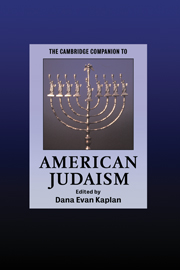Book contents
- Frontmatter
- Introduction
- Part I Historical overviews
- Part II Themes and concepts
- Section 1 Religious Culture and Institutional Practice
- Section 2 Identity and Community
- Section 3 Living in America
- 15 The American Jewish urban experience
- 16 "Sacred Survivial”revisited: American Jewish civil religion in the new millennium
- 17 Judaism and democracy in America
- 18 The economics of American Judaism
- 19 American Judaism and interfaith dialogue
- Section 4 Jewish Art in America
- Section 5 The Future
- Afterword
- Further reading
- Index
- Series list
19 - American Judaism and interfaith dialogue
from Section 3 - Living in America
Published online by Cambridge University Press: 28 May 2006
- Frontmatter
- Introduction
- Part I Historical overviews
- Part II Themes and concepts
- Section 1 Religious Culture and Institutional Practice
- Section 2 Identity and Community
- Section 3 Living in America
- 15 The American Jewish urban experience
- 16 "Sacred Survivial”revisited: American Jewish civil religion in the new millennium
- 17 Judaism and democracy in America
- 18 The economics of American Judaism
- 19 American Judaism and interfaith dialogue
- Section 4 Jewish Art in America
- Section 5 The Future
- Afterword
- Further reading
- Index
- Series list
Summary
Momentous transformations have taken place in the relationship between the Jewish community and other religious groups in America throughout the twentieth century. Tentatively beginning at the turn of the twentieth century, a movement of interfaith dialogue between Jews and non-Jews served as a catalyst that helped to bring about the changes. This dialogue gained more ground in the decades between the two world wars and advanced considerably following the Second World War. It reached a “golden age” in the late 1960s and 1970s, when an unprecedented momentum for reconciliation and dialogue between the faiths flourished in America. Despite occasional setbacks, the interfaith dialogue helped to improve the relationship between Jews and non-Jews in America, thus helping to advance the well-being of the Jewish community in America.
THE BEGINNING OF THE DIALOGUE
Interfaith dialogue between Jews and non-Jews in America began in the latter decades of the nineteenth century, primarily between liberal Protestants and Jews. Jewish and Christian clergymen cooperated over civic issues, invited each other to give talks in their congregations, and, at times, participated in interfaith conferences. Such interactions were on a sporadic basis and usually entailed personal friendships between Jewish and Christian religious leaders. A special occasion in the history of interfaith dialogue in America took place in 1893, when the World Parliament of Religions (WPR) convened in Chicago, bringing together Protestants, Catholics, Greek Orthodox Christians, Jews, Buddhists, Hindus, Bahai, Muslims, Native Americans, and representatives of other faiths as well.
- Type
- Chapter
- Information
- The Cambridge Companion to American Judaism , pp. 327 - 344Publisher: Cambridge University PressPrint publication year: 2005



